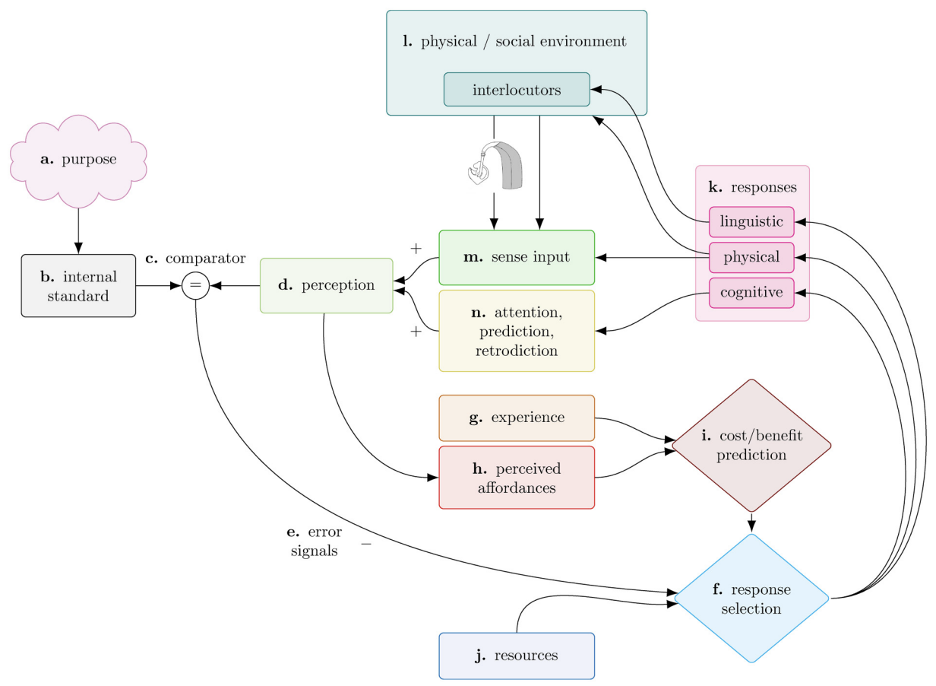Purposeful Adaptive Responses for Successful Auditory Functioning – A Brief Review of Beechey and Naylor 2025
The new conceptual model proposed by Beechey and Naylor (2025, DOI: 10.1177/23312165251317010) represents a significant advancement in understanding auditory function by placing adaptive, purposeful behaviors at its core. This model provides meaningful implications for people with hearing loss, auditory researchers, and the practicalities of assessing auditory function both in laboratories and the real world.

https://creativecommons.org/licenses/by/4.0
People with hearing loss face daily challenges that demand continual adaptations to understand speech and communicate successfully. Traditionally, hearing disability has been perceived mainly as a static deficit—the inability to hear certain sounds or frequencies. However, Beechey and Naylor argue that hearing disability should be understood through the individual's capacity to adapt to environmental demands. People naturally employ a range of adaptive strategies, categorized into cognitive, physical, and linguistic responses, to maintain auditory functioning in adverse conditions.
For example, in a noisy restaurant, a person might cognitively focus intensely on a companion's speech, physically lean closer or reposition themselves, or linguistically ask for repetition. These behaviors are goal-directed, meaning individuals actively adjust to minimize the difference between their current auditory experience and their desired outcome. Beechey and Naylor liken this process to how a GPS continually recalculates routes when encountering obstacles or how a thermostat maintains a comfortable room temperature, constantly adjusting until the set point is achieved.
The concept of ecological capacity introduced in their model is central. It encapsulates the individual's overall ability to utilize available adaptive strategies to meet the demands of the environment. For people with hearing loss, adaptive capacity might be limited—not just because of diminished auditory perception but also due to factors such as fatigue, social stigma, or physical constraints. These individuals may need to employ more extensive or intensive adaptive responses compared to those with normal hearing, thus incurring higher cognitive, physical, or social costs. The recognition of adaptive costs and benefits reframes how hearing loss is understood: the disability arises not just from auditory impairment but also from an insufficient capacity to adapt to environmental and social demands effectively.
For researchers measuring auditory function, this adaptive model challenges traditional laboratory methods. Laboratory assessments frequently restrict participant behavior (such as prohibiting movement), thus eliminating natural adaptive responses. Beechey and Naylor highlight that such constraints artificially inflate the gap between lab results and real-world auditory functioning. This bias arises because conventional lab conditions remove the natural feedback loops individuals rely on to maintain auditory performance. As such, researchers are encouraged to reconsider how they design experiments, aiming to allow or even incorporate adaptive behaviors. Doing so would yield results that are more ecologically valid—meaning that they are more representative of real-world scenarios.
An important implication for auditory researchers is the realization that focusing exclusively on auditory perception thresholds may underestimate an individual's actual functional capabilities. By neglecting the adaptive strategies people naturally employ, auditory assessments fail to capture the real-world auditory experience fully. This oversight has critical implications for the design and interpretation of clinical tests and the development of hearing interventions, which traditionally have focused primarily on compensating for auditory deficits through amplification or signal processing technologies.
Incorporating purposeful adaptive behaviors into research would better reflect actual functional outcomes. Ecological Momentary Assessment (EMA), a method capturing real-time adaptive responses in everyday settings, offers a particularly suitable research methodology aligned with Beechey and Naylor’s model. EMA allows researchers to document adaptive behaviors as they naturally occur, providing a richer and more accurate understanding of auditory functioning and disability in diverse, realistic environments. This method can bridge the gap between laboratory assessments and daily life experiences, capturing how individuals dynamically respond to changing auditory contexts.
For audiologists, the implications are profound. Rather than solely aiming to restore audibility, interventions might be designed to enhance individuals' adaptive capacities. This could include training programs targeting cognitive strategies (e.g., focused attention training), physical strategies (e.g., positioning and movement training), and linguistic strategies (e.g., social communication coaching). Hearing aids themselves might evolve to facilitate these adaptive strategies, perhaps through personalized adjustments informed by real-time assessments of adaptive behaviors.
The distinction between researcher and participant purposes highlighted by Beechey and Naylor is particularly noteworthy. Experimenters typically design tasks to detect specific thresholds or intelligibility levels, yet participants naturally strive to maximize their auditory performance. Recognizing this discrepancy is critical in the interpretation of data and in designing future research that genuinely captures real-world adaptive auditory functioning. Future experimental designs may benefit from explicitly incorporating measures of adaptive behaviors and acknowledging participant-driven goals alongside traditional auditory measures.
Overall, Beechey and Naylor's adaptive auditory model offers a holistic framework that more accurately captures the complexities of real-world auditory functioning. For individuals with hearing loss, recognizing adaptive capacities reframes hearing disability beyond mere auditory deficits. For researchers and clinicians, this approach demands methodological shifts towards greater ecological validity, ultimately enhancing the effectiveness and relevance of auditory assessments and interventions.
Reference
Beechey, T., and Naylor, G. (2025). How purposeful adaptive responses to adverse conditions facilitate successful auditory functioning: A conceptual model. Trends in hearing, Vol 29, 1-14. DOI: 10.1177/23312165251317010

